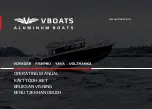
The flammability of gasoline and its
explosive properties must always be
respected. At the first odor of gasoline,
the engine should be shut off and remain off until the source of
the odor has been identified and the issue has been rectified.
Never smoke or operate any spark
producing object within a 50-foot range
of the boat when fueling. Fumes from
gasoline are more likely to produce an explosion and/or fire than
the actual fuel.
If fuel is spilled, always clean up with
dry rags and dispose of properly on
shore.
Use of incorrect fuel can result in dam-
age to the engine that is not covered by
the engine manufacturer nor by Malibu.
Failure to follow maintenance requirements may also void the
warranties.
Review the
Engine section of this
manual for important information
regarding the proper fuel to use, how to
maintain the fuel in use, how to maintain the fuel if the boat will
not be used for a period of time, and other important informa-
tion regarding the safe use of gasoline in the boat.
Malibu recommends returning to shore and refueling when-
ever the fuel gauge indicates that the fuel load has fallen below
one-quarter (1/4) of a tank full. It has been determined that contin-
uous operation with ballast significantly loaded either port or star-
board (rather than evenly distributed) can result in damage to the
MALIBU FUEL SYSTEM
Malibu models are equipped with the most up-to-date fueling
system available in the marine industry. The boats feature pump-
in-tank (PIT) fuel systems, which means the fuel pump is located
securely inside the fuel tank rather than at the engine. There are
many benefits to the PIT system, most significantly in the prevention
of vapor lock and improved filtration of contaminants.
To maximize the benefit of this type of fuel pump, the entire sys-
tem is under high pressure. That means that access to the pump and
fuel filter is only through fuel lines with a significant pounds-per-
square-inch (PSI) pressure to ensure proper operation. As such, no
one can or should ever attempt to access any portion of the fuel sys-
tem without proper training and proper equipment.
The fuel lines are
covered in orange “fire-sleeve” protective covering so that they are
easily identifiable, and consumers should always avoid these lines,
unless it is noted that one is squeezed or pinched.
If it is possible
to alleviate this situation safely, then do so. The preferable method,
however, is to have an authorized Malibu dealer’s trained service
technician do so and verify that no damage has been done to the line
or other equipment.
Normally, if there is any issue arising from damage or leakage in
the fuel system a strong odor of gasoline will be present and signi-
fies that the engine should not be started due to the danger of ex-
plosion from fumes. Even in the absence of a gasoline odor, owners
and operators should always visually check the fuel system prior to
operation, as directed in the Care and Maintenance section of this
manual.
The fuel system, including the fuel
lines, filter, and pump, should never
be serviced by any person other than
an authorized Malibu trained service technician. Special tools
and training are required to safely service the fuel system on all
models. When opened or penetrated, the high pressure lines can
cause serious injury or death.
Get Ready—127
GET READY
















































